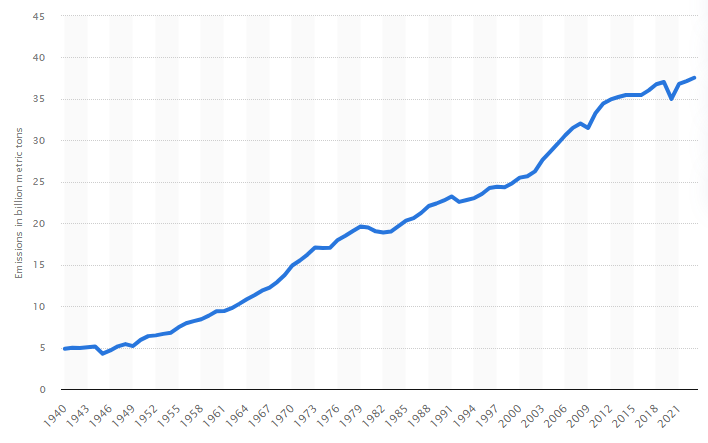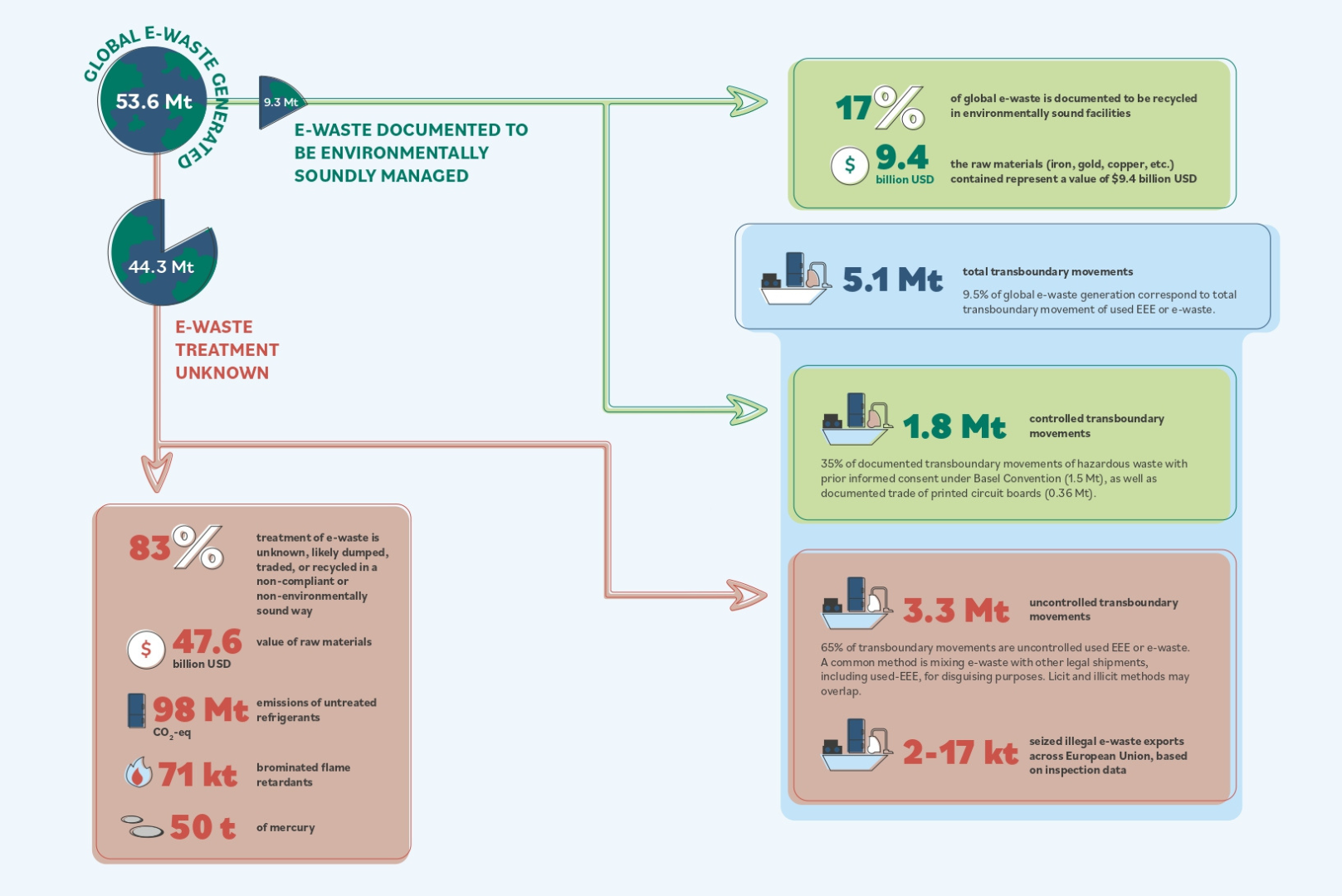Content
- Current Environmental Challenges in Tech
- How Do We Mitigate These Challenges?
- Energy Efficiency and Renewable Energy Sources
- Sustainable Manufacturing Practices
- Green Data Centers and Cloud Services
- Investing in Green Tech Innovations
- Regulatory Compliance and Industry Standards
- Educating and Engaging Stakeholders
- Collaboration for Sustainable Solutions
- What's next?
Technologies have become an inseparable part of approximately 65.7% of the world’s population. Just imagine that 5.3 billion people use at least one of the four common devices to access the Internet daily.
Smartphones, tablets, PCs, laptops, and other technical devices are composed of electronic components, the production of which requires a significant amount of resources in addition to materials. Primarily, this involves electrical energy accompanying the creation process of any element, from semiconductors to data carriers, monitors, and so on.
This is just a small part of the impact that the planet’s ecology undergoes due to total digitization. Carbon emissions from the operation of each electronic device, along with the enormous amount of waste from obsolete products, gradually transform the Earth into a kind of sponge that initially absorbs harmful substances and eventually returns them to humanity in full. The consequences will be fatal.
However, most problems and harmful effects can be mitigated by responsibly approaching global digitization.
Current Environmental Challenges in Tech
Any electronics during production irrationally consumes natural resources, such as water, air, and rare metals. Additionally, chemical processes are applied to create certain materials, such as plastics for casings, causing harm to the environment.
Similar examples can be almost endless, but we propose to focus more on the most acute aspects of the technological sector’s impact on the environment. And also on methods that will help minimize its damage without compromising production efficiency.
Harmful Emissions

Source: Statista
By 2023, the global level of CO2 emissions into the atmosphere exceeded 37.55 billion tons. This is only from the use of fossil fuels and industrial capacities. Based on IEA data, electricity production has led to the release of almost 15 gigatons of CO2 into the atmosphere. This concerns the industry.
In the social sector, the situation is also not the best. As per the European Commission’s estimate (EDGAR), the average emission per capita (approximately 7.954 billion) was about 6.762 tons per year in 2022.
The worst indicators are recorded in six key industrial regions: China, the United States, India, EU27 countries, Russia, and Brazil. Although some EU27 countries (Lithuania, Estonia, Belgium, the Netherlands, Luxembourg) managed to reduce emissions.
Electronic Equipment Recycling
Technological development leads not only to improving technical production processes and the quality of finished products but also to complicating the mechanisms of recycling. For example, a typical printed circuit board used in electronics contains many metals, chemical compounds, and so on. Semiconductor elements, such as modern processors and accumulators, are even more challenging to produce and, especially, to recycle used devices. EWasteMonitor predicts that by 2030, humanity will generate around 74.7 metric tons of electronic waste annually, and by 2050, over 110 million tons.

Source: EWasteMonitor
Recent studies by the EWasteMonitor agency show that approximately 83% of discarded devices are disposed of through methods like incineration, deformation, dumping remnants into common landfills, etc. An approximate estimate of the materials that could be obtained through proper technological recycling reaches $47.6 billion.
Excessive Electricity Consumption
As stated by the IEA, from 2021 to 2023, global electricity demand decreased almost by half (from 1421 TWh to 705 TWh), but there is a trend of gradual growth. Regarding sources, in 2023, non-renewable energy (fossil fuels) dominated, covering 60% of consumer needs (industry, business, population).
As of the beginning of 2024, the share of green energy in consumer needs is approximately 20%. IEA concluded that the electricity decarbonization program (50% by 2050) may fail without significant acceleration in the development of clean energy technologies.
Rare Material Expenditure
Did you know that our devices contain a significant portion of the periodic table of elements? Chemical compounds, rare earth metals, and synthetic materials are traditional components of smartphones. Specialized equipment is even more technologically complex.
Industrial equipment, modern data centers, and consumer electronics use colossal volumes of non-renewable materials. Due to the depletion of natural resources and improper disposal of used products (such as vital elements), people may be left without essential resources for 50-100 years.
How Do We Mitigate These Challenges?
The solution to the problem is a straightforward one: a reconsideration of values and responsibility, especially by mega-corporations that often disregard the future in pursuit of immediate profits.
Solution #1: 100% transition to renewable energy sources
Nuclear and coal industries can generate excess power at the cost of emitting a massive amount of CO2 and depleting natural resources. Renewable sources like wind, water, and solar radiation can eventually replace other types of generation. However, this requires a powerful upgrade of technologies and equipment.
Solution #2: Responsible electronics waste disposal
The secondary market for used devices, modern recycling centers (where each component is disassembled and processed separately), and the development of a recycling culture among the population can reduce the amount of electronic waste on the planet and create a renewable source of materials (including rare ones) for further use in production.
Solution #3: Deindustrialization, as cliché as it may sound
Investing in green economy, energy, and industry is an investment in the future of the next generations. Only a combination of modern technologies and, e.g., forest expanses (which most efficiently process CO2) will allow humanity to maintain organic living conditions on the planet.
The health of people, ecosystems, biomes, and the Earth as a whole is a priority worth compromises. We present an overview of strategies that will most effectively combine progress and ecology.
Energy Efficiency and Renewable Energy Sources
Fossil resources for the energy sector, applicable to all industries, are limited consumables. In addition to consuming resources, nuclear, coal, and gas power plants emit CO2, thereby doubling the environmental damage.
Add to this the widespread use of chemical compounds to increase efficiency, harmful elements settling on the planet’s surface, and penetrating groundwater, etc. The damage is colossal, although the efficiency of such power sources currently lacks competitive alternatives.
Green energy, using renewable resources for electricity generation by converting the kinetic energy of water or air into mechanical energy and electricity, can cover a significant portion of consumer needs. However, this is a long-term perspective for which transformation should begin today.
Minimizing Electricity Consumption
The responsibility of society and businesses is a key pillar supporting the possibility of transitioning to a Zero Carbonized energy supply model.
According to OurWorldInData, the average global annual electricity consumption per person is 21,039 kWh. This is only for consumer sectors that use a considerable number of household and personal electrical devices to create comfortable living conditions.
Reducing electricity consumption in modern conditions is challenging but possible. To achieve this, one can:
- Use network-connected devices only when needed.
- Save the device battery and charge it less frequently.
- Limit electricity use in cold weather and during peak system loads.
It is also worth equipping buildings (where possible) with autonomous power sources, such as solar panels and wind turbines.
Using renewable energy sources and upgrading equipment and devices to modern technologies are also crucial for industries and businesses.
Creating an Efficient Infrastructure for Renewable Energy Sources
Wind turbines, solar panels, and hydro generators are the simplest and most effective solutions for transforming natural energy into electricity. Yes, they also generate CO2, but in much smaller quantities than power plants that rely on combustion processes, chemical reactions, etc.
Deploying extensive electricity production through these methods will require preparing specific spaces (fields for solar panels and wind turbines, shores, and river channels for hydrogenation). However, with a smart strategy, losses to nature can be minimized, and maximum efficiency can be obtained from the newly created infrastructure.
Equipment Modernization, Increasing its Efficiency
The development direction of manufacturing technologies is already on the right path. Recycled materials are used, the energy efficiency of electronic components is increasing, technical processes are improving, and so on. However, companies, for various reasons, are not rushing to replace outdated equipment with new solutions.
Data centers, in particular, demonstrate this issue well since the current cost of server equipment does not allow for a timely migration to newer tech stacks without losses. Part of this problem is solved with the secondary market and the ingenuity of Chinese engineers. However, this brings us back to the issue of significant electricity consumption by ordinary users.
The optimal way to stabilize the situation is the proper disposal of outdated equipment by the manufacturer and the exchange of used equipment for new with discounts or partnership programs. The result is excellent: the manufacturer gets renewable resources for making components, and the consumer can quickly upgrade their equipment, reducing used electricity and CO2 emissions.
Sustainable Manufacturing Practices
The sustainable development strategy is gaining popularity among businesses of all levels and directions. In 2024, a significant portion of investment programs will focus on decarbonizing production and routine processes such as commercial activities, logistics, and IT infrastructure.
Some market leaders have already made progress in green production. For instance, Tim Cook announced that Apple has become a completely carbon-neutral company. The tech giant achieved this through innovative measures:
- Abandoning the use of newly extracted materials for manufacturing.
- Transitioning to 100% renewable energy sources (solar panels, wind turbines).
- Maximizing the greenery of industrial and office areas, including buildings and rooftops.
- Implementing upgrades to reduce heating and cooling costs.
- Introducing a program for recycling used Apple devices to reuse materials in new products.
As a result, almost all processes and equipment of the company, including massive data centers, are practically 100% environmentally friendly, generating minimal CO2 emissions. This case demonstrates the potential strategy for brands to transition to resource-efficient management.
Green Data Centers and Cloud Services
Cloud technologies, a trend of the decade, have become a daily reality. Thousands of services, thousands of mobile and computer programs, enterprise infrastructures, and even government operations run on remote servers. AI with ML further expands the list of algorithms used by cloud hosting service providers.
All of the above consume a colossal amount of electricity and generate significant CO2 emissions into the atmosphere. This automatically leads to the concept that modern technologies do not contribute to the decarbonization of the tech sector. However, this is not entirely true.
When it comes to organizing data centers with a massive amount of equipment, the environmental impact there would be substantial. But as of the beginning of 2024, more and more companies are applying modern equipment management methods. Let’s talk about a few of them.
Mass Greening of Production Facilities
Let’s return to Apple, where Tim Cook discusses the brand’s decarbonization. The presentation repeatedly demonstrates the organization of the corporate park’s territory and its premises, including data centers. Pay attention to the number of plants constantly appearing in the frames.
Plants, combined with well-organized workspaces, are the components that absorb almost the entire volume of CO2 generated by equipment operation.
Yes, this affects emissions directly in data centers but not near users interacting with cloud services. Nevertheless, it is still a significant contribution to nature conservation that businesses with data centers and a substantial amount of electronic equipment should follow.
Transformation of Processes from Quantitative to Qualitative Indicators
Statista analysts predict that by 2028, exclusive mobile traffic in the U.S. will reach 329 exabytes (EB) per month. Meanwhile, the global volume of digital data will exceed 180 zettabytes (ZB) by 2025. Extensive capacities are required to store and process such a massive amount of information. And the more equipment used in these processes, the more CO2 emissions can be expected.
However, technological progress can mitigate this dependency. For example, even ordinary users can now access 1TB+ storage devices that easily fit into a pocket and generate minimal CO2. In other words, the more extensive storage devices become, the more their technical processes improve, and the less equipment will be needed in data centers. This applies to other components such as processors, RAM, switches, etc.
Investing in Green Tech Innovations
As stated in the research on Decarbonization by the PWC group, the Net Zero Economy program is developing seven times slower than planned. Moreover, there has been a significant reduction in investments in the green economy during 2021-2023.
The reasons for this varied, from increased production levels, particularly in military equipment and ammunition (due to current global issues), to inflation, economic fluctuations, etc. However, based on PWC data, businesses and governments worldwide clearly understand the need to maintain the global warming limit within 1.5°C. Therefore, in 2024, there is a focus on increasing investments in long-term decarbonization projects across all sectors, with a particular emphasis on the industrial sector.
The technological niche has a lesser impact on the environment but offers broader decarbonization possibilities in the short term. If companies can attract investments and focus on greening their business, they can accelerate the development of the Net Zero Economy program and gain additional benefits for their operations.
Regulatory Compliance and Industry Standards
The critical issue that the Net Zero Economy aims to address is CO2 emissions contributing to the greenhouse effect and gradually raising the planet’s average temperature. International expert groups have developed recommendations and algorithms for each sector, compliance with which will reduce carbon generation by 50% by 2050. Environmental authorities worldwide must additionally monitor and regulate companies’ adherence to the established decarbonization course.
Failure to do so could result in natural catastrophes, disease outbreaks, and disruptions affecting everyone. What better incentive to focus efforts on mitigating potential causes?
Educating and Engaging Stakeholders
Environmental issues might seem to concern investors and business owners, yet not everyone approaches this matter as responsibly as Apple. Samsung, while moving towards decarbonization, has not been as successful. In 2022, the company reported 19.6 million metric tons of CO2 emissions, three times higher than 2014 figures, according to Statista analysts.
This underscores the importance of communicating with the management of tech giants and encouraging them to intensify efforts to adhere to the Net Zero Economy course, adopt renewable energy sources, use recycled materials, modernize technical processes, etc.
Collaboration for Sustainable Solutions
As reported by Accenture’s research on Net Zero Economy progress:
- 37% of companies plan to reduce CO2 emissions.
- 33% are decarbonizing but at a slow pace.
- 18% of brands potentially aim for zero CO2 by 2050.
The latter not only upgrade their facilities, equipment, and territories but also actively invest in green startups. They gain early access to new solutions and technologies, reducing carbon emissions at the expense of these investments.
This once again demonstrates the importance of supporting initiatives to improve the environmental friendliness of processes.
What's next?
Preserving natural resources, climate, and air cleanliness is a critical task for urbanized society, especially for industrial and technological giants. Aside from protecting the environment and enhancing the planet’s quality of life in the long term through its restoration, decarbonization, and the green economy are financially advantageous.
Investing in Net Zero Economy projects has several benefits, such as:
- Energy independence for companies, means lower electricity costs.
- Almost infinite resources are available through the recycling of outdated and damaged products.
- Higher investor trust and audience credibility by demonstrating the company’s maturity.
Each of us, whether a regular consumer or a technological giant, can and should contribute to ecology. It’s a challenging path, but it’s the only one that guarantees the same benefits of civilization for future generations as we enjoy now. Otherwise, we risk losing all progress one day and rolling back to a time when the planet regulated life itself.
Therefore, let’s be responsible.


